Henry Avery's raid of the Mughal ship Ganj-i-Sawai earned him the equivalent of about $125 million in today’s money — and led to the first international manhunt.
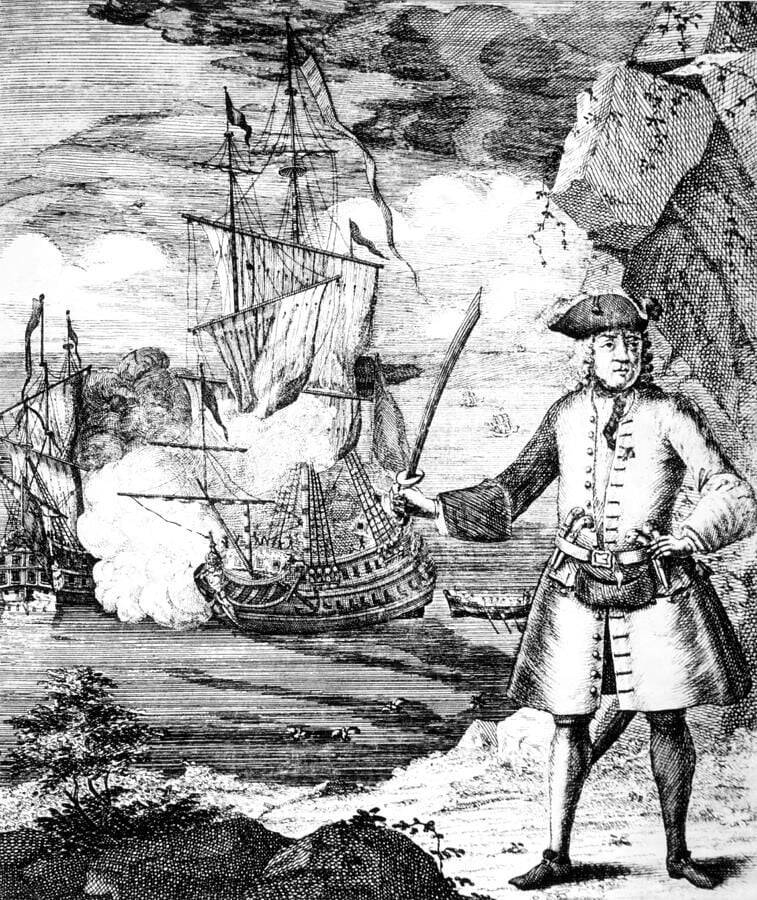
Public DomainAn 18th-century depiction of Henry Avery and his ship Fancy.
Before Calico Jack and legends of the Jolly Roger began to shape the image of piracy, there was Henry Avery, “The King of the Pirates.”
Also known as Henry Every, Avery was a late 17th-century English seaman. His early life as a British Navy officer and slave trader had given him the skills he needed to successfully captain a ship — and after a job for the English turned sour in 1694, Avery turned to piracy, leading a series of successful raids in the Atlantic and Indian Oceans.
However, his biggest success came with the plundering of the Mughal ship Ganj-i-Sawai. He and his men sailed away with the equivalent of as much as $125 million in today’s money, making their attack the most lucrative heist in pirate history.
Afterward, Henry Avery vanished without a trace, becoming one of the very few buccaneers who escaped with their loot without being arrested or killed. His mysterious disappearance continues to puzzle historians to this day, further fueling his reputation as one of history’s most influential pirates.
Captain Avery’s Early Life And Career In The Royal Navy
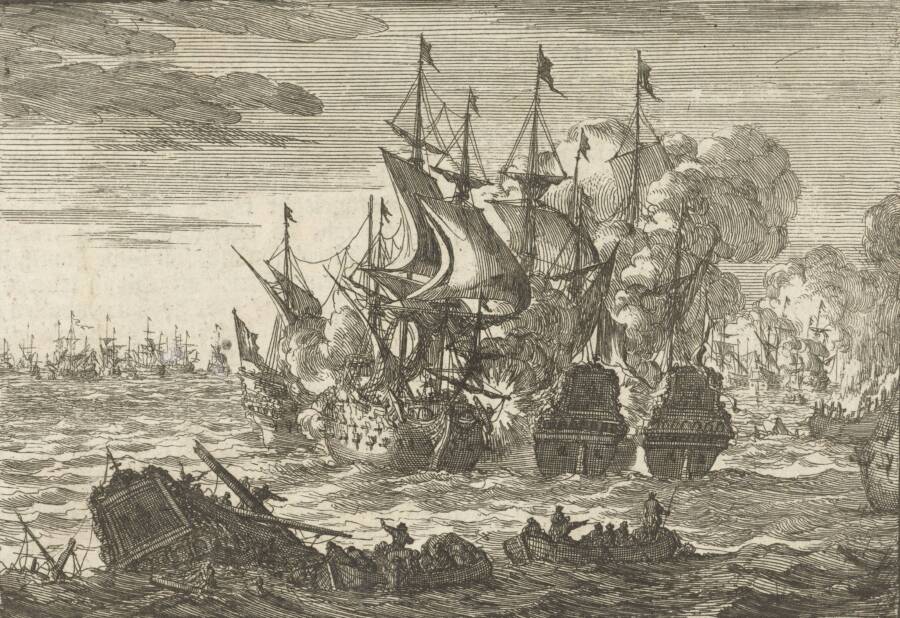
Rijksmuseum/Wikimedia CommonsHenry Avery may have fought in the Battle of Beachy Head in 1690, when a French fleet defeated a combined force of English and Dutch ships.
Henry Avery was born sometime between 1653 and 1659 near Plymouth, England. Otherwise, very little is known about his early life.
In his youth, Avery trained as a sailor and then joined the Royal Navy, working on various Naval ships. During the Nine Years’ War — a conflict fought between England and Louis XIV of France — Avery reportedly served as a midshipman on the HMS Rupert. By 1690, Avery was promoted to petty officer and was likely present for a handful of key battles during the war.
Soon after, however, Avery left the Royal Navy and set his sights on the slave trade.
Employed by the governor of the Bahamas, Avery sailed up and down the Guinea coast, illegally transporting enslaved people. While there is little record of this part of his life, he developed a reputation for being a particularly cruel slave trader, allegedly tricking other slave traders by hoisting friendly flags — and then kidnapping them as well.
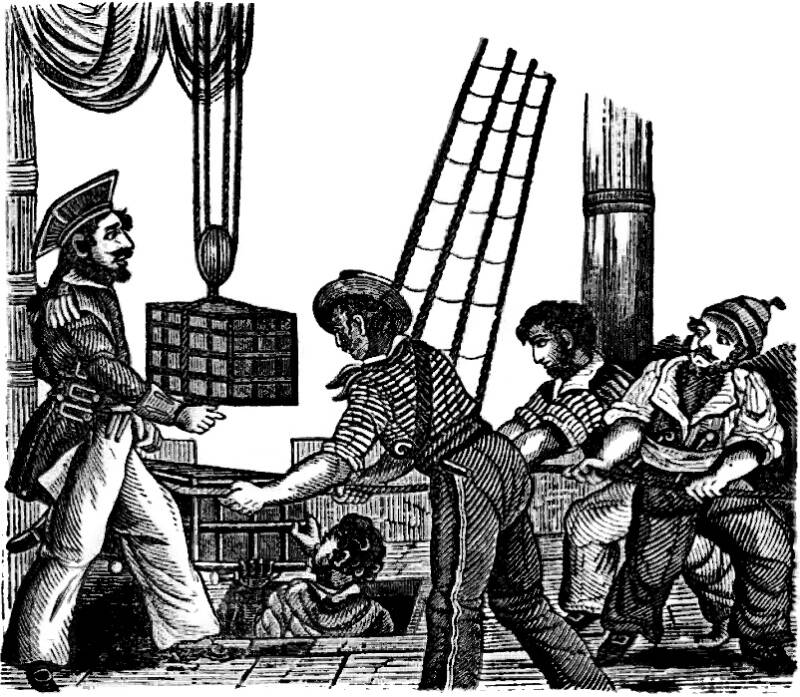
Wikimedia CommonsCaptain Avery set off on a piracy career along the coast of Africa, where he’d condemned countless people to slavery after leaving the Royal Navy.
In 1693, Avery joined the Spanish Expedition Shipping voyage, an English plot to plunder French vessels in the Caribbean. His experience with the Navy earned him the title of first mate during the venture.
That year, four warships involved in the expedition were set to sail to La Coruña, Spain. But everything seemed to go wrong with the mission. The crew ended up stranded at port for months on end without pay due to a series of missteps and bureaucratic issues.
In May 1694, Avery capitalized on the crew’s discontent and rallied them to stage a mutiny, seizing their ship, Charles II, and renaming it the Fancy. In a unanimous vote, Avery became the ship’s new captain, thereby launching his piracy career.
Henry Avery Takes Up A Life Of Piracy

Wikimedia CommonsA woodcut of pirate Henry Avery from Captain Charles Johnson’s A General History of the Robberies and Murders of the Most Notorious Pyrates (1724).
With Henry Avery as their captain, the restless crew of the Fancy yearned for wealth.
Only a year earlier, the infamous pirate Thomas Tew had supposedly led a successful raid in the Red Sea and made away with riches the men of the Fancy could only dream of. This story inspired the crew to sail to the Indian Ocean.
Avery’s crew committed its first act of piracy in the Cape Verde islands, robbing three English merchant ships that were heading to Barbados. From there, Avery sailed down the Guinea coast, which was by then very familiar terrain for him.
In the Bight of Benin, Avery purportedly had the Fancy razeed, making it one of the fastest ships in the Atlantic Ocean. The ship continued on its journey, stopping at South Africa, Madagascar, and the Comoros Islands and picking up several new crew members along the way. By 1695, Avery commanded a crew of 150 men.
While in the Comoros Islands, Avery wrote a letter to England’s ship captains at large, falsely declaring that he had never raided English ships and had no intention of doing so. Many of these captains worked for the East India Company, whose vast and powerful fleet could easily destroy the Fancy, and Avery likely hoped to placate them.
“To all English. Commanders lett this Satisfye that I was Riding here att this Instant in y’e Ship fancy man of Warr formerly the Charles of y’e Spanish Expedition who departed from Croniae [Corunna] y’e 7th of May. Being and am now in A Ship of 46 guns 150 Men & bound to Seek our fortunes I have Never as Yett Wronged any English or Dutch nor never Intend whilst I am Commander.”
Despite this attempt at diplomacy, the Crown remained steadfast in its pursuit of Henry Avery. And it only became more determined to capture him when Avery successfully pulled off the most profitable raid in pirate history.
Conducting The Most Lucrative Piracy Raid In History
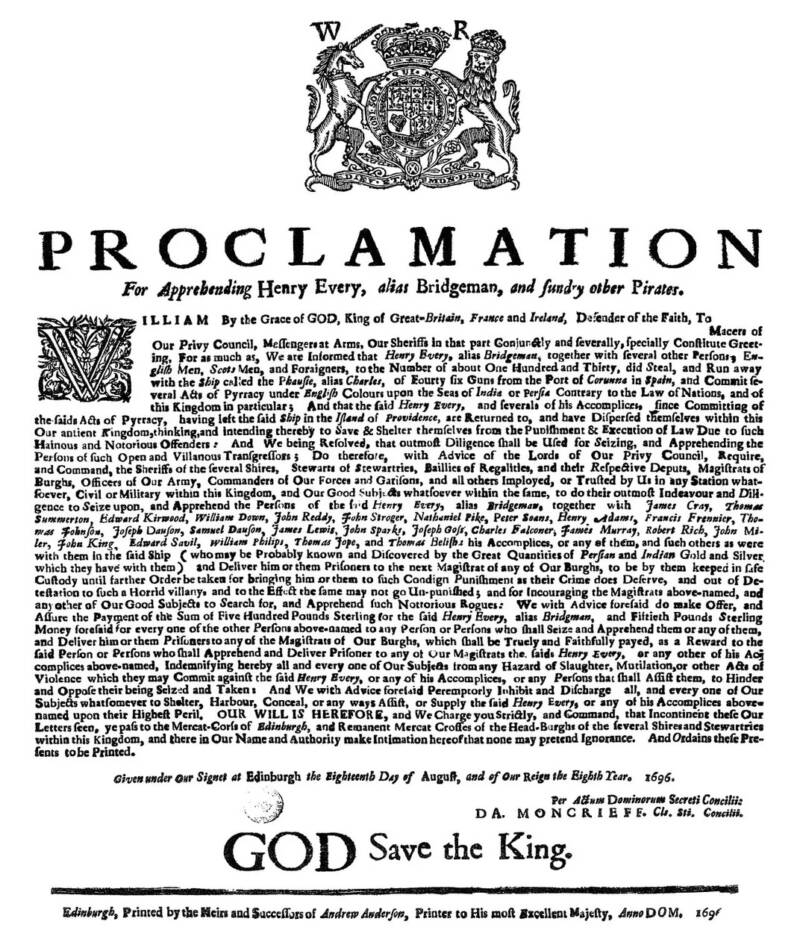
Public DomainA royal proclamation calling for the capture of Henry Avery in 1696.
In the summer of 1695, Henry Avery and his crew sailed to the Red Sea to await an incoming Mughal fleet.
Led by Grand Mughal Aurangzeb, the Mughal Empire was one of the wealthiest empires in the world. Its fleet included 25 massive ships carrying precious jewels and metals worth up to £600,000 — the equivalent of £97.1 million today, or about $125 million.
On a warm August night, the crew of the Fancy chased after the fleet and attacked the Mughal flagship, Ganj-i-Sawai.
Although they had teamed up with several other pirate ships, including Thomas Tew’s Amity, Avery’s men were far outnumbered. The Ganj-i-Sawai alone had around 40 cannons and 400 soldiers onboard. Still, Avery’s crew fought fiercely against the Mughal sailors, and after two hours, they boarded the Ganj-i-Sawai victorious.
While onboard, Avery and his men reportedly subjected the ship’s passengers to extreme brutality. The pirates tortured the Mughal men for days for information about the location of the treasure and sexually assaulted the female passengers. Henry Avery himself allegedly sexually assaulted an elderly relative of Grand Mughal Aurangzeb.
“The whole of the ship came under their control and they carried away all the gold and silver,” historian Khafi Khan later wrote, according to History. “After having remained engaged for a week, in searching for plunder, stripping the men of their clothes and dishonoring the old and young women, they left the ship and its passengers to their fate. Some of the women getting an opportunity, threw themselves into the sea to save their honor.”
After raiding the Ganj-i-Sawai, the pirates eventually retreated to their ships and made off with their historic loot. It was enough treasure for each crew member to live on for a lifetime.
And Henry Avery was the richest pirate in the world.
The World’s First International Manhunt
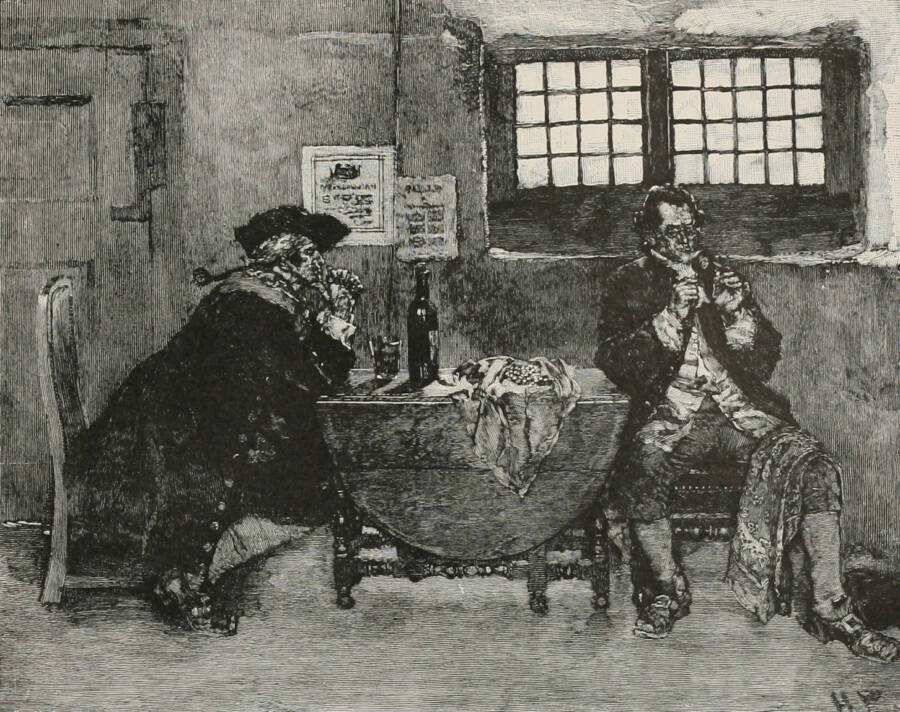
Wikimedia CommonsAlthough some writers have suggested that Henry Avery was cheated out of his treasure and died a pauper, his true fate remains unknown.
Following Henry Avery’s raid of the Ganj-i-Sawai, relations between the Mughal Empire and the British soured. Enraged over the attack, Emperor Aurangzeb seized the East India Company’s factories and called for the arrest of several Englishmen in India.
The East India Company promised to pay the Mughals damages for the raid, and soon focused its attention on capturing Henry Avery. The British government issued a bounty for the pirate, which the East India Company doubled.
For the first time in history, an international manhunt was underway.
Back on the high seas, Avery and the crew of the Fancy were making their way to the Bahamas. There, Avery bribed Nicholas Trott, the governor of New Providence, to allow them to come ashore, promising to give him the Fancy and a cut of their treasure.
Eventually, the East India Company tracked the Fancy to New Providence. But by that point, most of the crew had escaped the island, scattering across Europe and America.
In total, 24 of Avery’s men were captured, and five were executed. But Henry Avery escaped.
Captain Avery’s Mysterious Disappearance
To this day, no one knows for sure what became of the Pirate King, though a number of theories have emerged over the years.
Some say that Avery hitched a ride on the ship Sea Flower in 1696 and made his way to Ireland, where he lived out the rest of his life in peace. Others have suggested he fled to Madagascar and started a pirate enclave there, or that he returned to his native England and died penniless after being cheated out of his treasure.
Then, in 2024, two shipwreck explorers discovered a coded letter written by someone called “Avery the Pirate” in the Scottish archives.
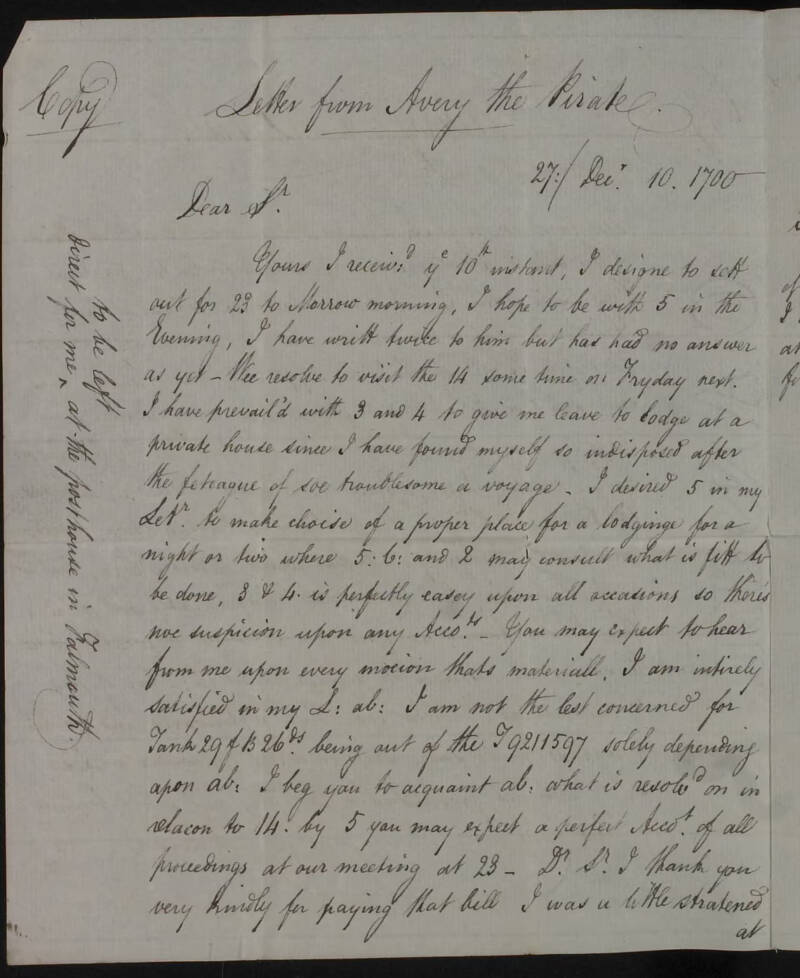
Scottish Records OfficeA coded letter from “Avery the Pirate.”
As The Guardian reports, the letter was dated December 1700 and addressed to Reverend James Richardson on Orange Street, London. Richardson’s address is so obscure that the shipwreck explorers believed the letter was undoubtedly authentic.
According to the explorers, this letter offers evidence that Henry Avery not only went back to England following his legendary raid, but that he participated in King William III’s early 18th-century spy ring alongside figures like Daniel Defoe, author of Robinson Crusoe, and Thomas Tenison, the archbishop of Canterbury.
This theory has yet to be definitively proven. But regardless of what happened to the Pirate King, Henry Avery’s legacy remains as one of history’s most successful pirates.
After reading about Henry Avery, dive into the story of Anne Bonny, the female pirate who fiercely fought alongside Calico Jack. Then, read the true story of Samuel Bellamy, the richest pirate in history.





